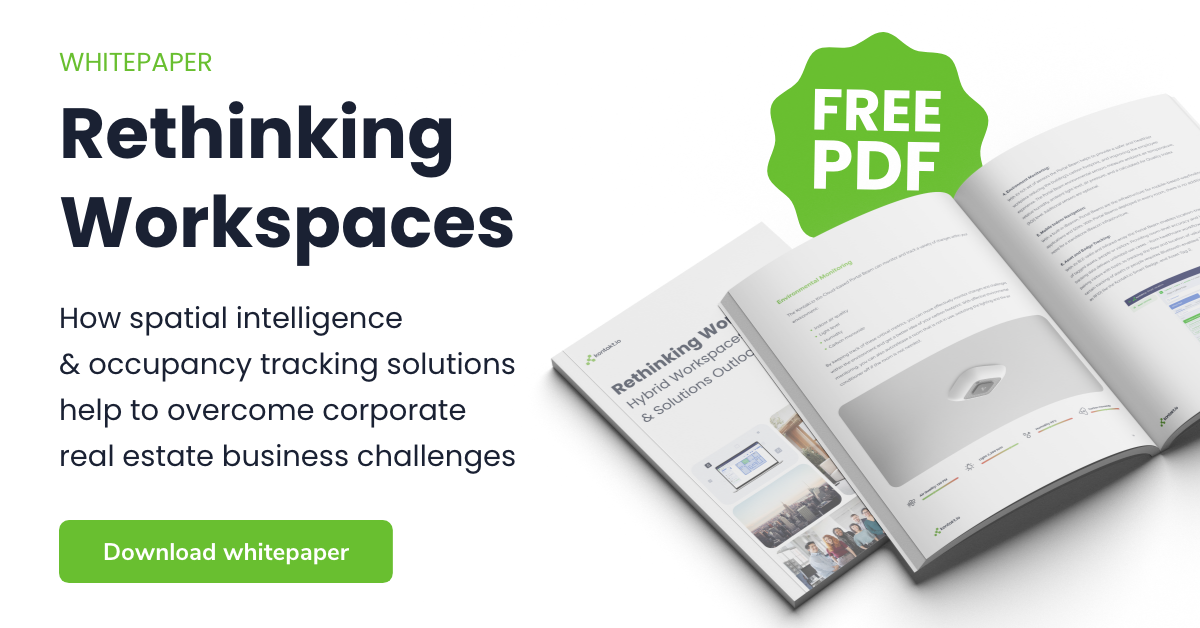
Moving on from the pandemic, digital solutions are taking on more prominent roles in the use and management of workspaces. Rather than, say, simply tracking movement of people or assets, they are now turning to new applications that enhance the complete worker or visitor experience.
Table of Contents
The definition of a truly “smart” building is evolving to include new metrics. This doesn’t mean that the conventional understanding of smart buildings is being replaced, just expanded. Things like occupancy monitoring, foot traffic measurement and other metrics will always be needed to ensure that stakeholders have real-time insights into the current status of various spaces.
But lessons learned during the pandemic are being applied as building owners, property managers and others were able to use months of empty office spaces to rethink some basic assumptions about how we use space. Offices are no longer viewed as a place to get things done, but a space where employees live and work while getting things done.

Highlighting the difference between those two views is aided by the easy availability of data that presents graphic presentations of how space is used. This data replaces assumptions, guesses and estimates with a clear and accurate picture of how spaces are really used. This has become key in accommodating the new trend of hybrid workspaces, which depend not only on instant access to occupancy levels but historical data on space utilization.
Kontakt.io is playing a crucial role in this new approach that prioritizes providing occupants with comfortable, useful, and safe indoor experiences by providing the human-building interfaces that let spaces work for people.
The pandemic ended our traditional relationship with workspaces and forced a rethink about how we use real estate, the second-largest expense line for most companies. How to make smart workspace?

The first smart building solutions were focused on simple operational improvements and automations and now how those upgrades actually improved the experience of using the building. Also, circumstances have created a unique opportunity for a reset in our assumptions about how we interact with workplace environments — we’re transitioning back to the office and the time to reset how we use our space and create new routines is now, before the previous status quo takes over again by default.

Adapting to the new reality of office spaces and leveraging the solutions available first requires a change in approach. Spatial Intelligence is the foundation of this new understanding.
Kontakt.io digital building services illustrate indoor interactions between equipment, people and spaces, making a number of use cases possible, including:
From tracking room and even seat-level occupancy in real time to real-time access to exact footfall traffic in any monitored area and more, we provide the data-driven insights that replace guesswork and estimates with an accurate snapshot of how space is used at any given moment and over time.
Everyone now has access to IoT-based infrastructures that make it easier than ever to collect data that can be leveraged into Spatial Intelligence. Just two years after the major disruption that created the need for it, Spatial Intelligence has already proven itself to be of critical importance in a number of performance metrics.

Investing in technology and a renewed focus on employee well-being have both been given new importance in the post-pandemic era but they have rarely intersected as they do here. Leveraging the power of new technologies to create better interactions between employees and their workspaces is now available, affordable and easily deployed.
We are creating a new understanding of the workplace that is human-centric. Our digital building services transform workspaces into environments that promote the safe, productive and sustainable use of real estate. This will help you to answer the question how to use workspace effectively.
Until now, most Smart Building solutions have failed to take the final step that makes automated processes and other tech-driven features work to the advantage of people who work there. At Kontakt.io, we believe that this is where the true benefits are — the point where all those impressive technical capabilities result in concrete, measurable improvements in the experience of the building occupants. Learn more about smart building solutions by scheduling a talk with our team today.

How smart hospital solutions are delivering better clinical outcomes, greater efficiencies, and higher patient satisfaction through digital transformation using technologies like Internet of Things (IoT) and Artificial Intelligence (AI)
Turn your workspace into a modern one with Kontakt.io spatial intelligence solutions.
Learn how we can help improve employee experience, decrease carbon footprint, and
help you understand how your space is utilized in a SIMPLE & AFFORDABLE way.